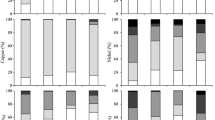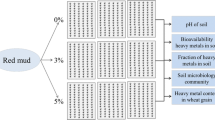Abstract
A chelator, potassium dipropyl dithiophosphate, and humic acid were combined and used as a stabilizing agent to study the stabilization effect of the mixture on heavy metals in a contaminated sediment. The results indicated that the stabilization efficiencies for Cu, Zn, Pb, and Cd in the sediment were up to 99.98, 90.66, 99.38, and 92.83%, respectively, and the unstable Cu, Zn, Pb, and Cd fractions fell by 57.11, 54.74, 56.41, and 89.14%, respectively, when 5% potassium dipropyl dithiophosphate and 7% humic acid were added. This significantly reduced the bioavailability of the heavy metals. Under leaching caused by simulated acid rain (pH 3 and pH 5), the heavy metals mainly migrated from the solid phase to the liquid phase during the initial leaching period, and the Pb, Cu, Zn, and Cd leaching rates in the sediment after stabilization fell by 55–99%. Cu showed the greatest reduction. When the results for the sediment after stabilization were compared with the sediment before stabilization, the wheat stem height had increased by 53.62%, the dry weights of the leaves and roots increased by 86.25 and 34.85%, respectively, and Cu, Zn, Pb, and Cd enrichment in the wheat roots and leaves fell by 40–88 and 73–95%, respectively.






Similar content being viewed by others
References
Amirhossein, P., Gholamreza, N. B., Mojtaba, A., Mohsen, S., & Akbar, B. (2015). A new index for assessing heavy metals contamination in sediments: a case study. Ecological Indicators, 58, 365–373.
Ata, A., Ceren, E., Sevda, O., Viviana, F., & Francesca, B. (2015). A review of approaches and techniques used in aquatic contaminated sediments: metal removal and stabilization by chemical and biotechnological processes. Journal of Cleaner Production, 86(1), 24–36.
Canet, R., Chaves, C., Pomares, F., & Albiach, R. (2003). Agricultural use of sediments from the Albufera Lake (eastern Spain). Agriculture, Ecosystems and Environment, 95(1), 29–36.
Chen, Q. Y., Tyrer, M., Hills, C. D., Yang, X. M., & Carey, P. (2009). Immobilisation of heavy metal in cement-based solidification/stabilisation: a review. Waste Management, 29(1), 390–403.
Chen, J. Y., Luong, H. V. T., & Liu, J. C. (2015). Fractionation and release behaviors of metals (In, Mo, Sr) from industrial sludge. Water Research, 82, 86–93.
Dorota, K., Zygmunt, M. G., Katarzyna, B., & Barbara, K. (2015). Feasibility of using humic substances from compost to remove heavy metals (Cd, Cu, Ni, Pb, Zn) from contaminated soil aged for different periods of time. Journal Hazardous Materials, 30, 882–891.
Grega, E. V., & Domen, L. (2013). Equilibrium leaching of toxic elements from cement stabilized soil. Journal Hazardous Materials, 246–247, 18–25.
Guan, Q. Y., Wu, D. Y., Lin, Y., Chen, X. C., Wang, X. Z., Li, C. J., He, S. B., & Kong, H. N. (2009). Application of zeolitic material synthesized from thermally treated sediment to the removal of trivalent chromium from wastewater. Journal Hazardous Materials, 167(1–3), 244–249.
Guan, Q. Y., Wang, L., Pan, B. T., Guan, W. Q., Sun, X. Z., & Cai, A. (2016). Distribution features and controls of heavy metals in surface sediments from the riverbed of the Ningxia-Inner Mongolian reaches, Yellow River, China. Chemosphere, 144, 29–42.
Güler, T., Hicyilmaz, C., Gökaĝac, G., & Ekmeci, Z. (2006). Adsorption of dithiophosphate and dithiophosphinate on chalcopyrite. Minerals Engineering, 19(1), 62–71.
Huo, S. L., Zhang, J. T., Yeager, K. M., Xi, B. D., Qin, Y. W., He, Z. S., & Wu, F. C. (2015). Mobility and sulfidization of heavy metals in sediments of a shallow eutrophic lake, Lake Taihu, China. Journal Environment Sciences, 31, 1–11.
Jiang, J. G., Wang, J., Xu, X., Wang, W., Deng, Z., & Zhang, Y. (2004). Heavy metal stabilization in municipal solid waste incineration flyash using heavy metal chelating agents. Journal Hazardous Materials, 113(1–3), 141–146.
Kolodynska, D. (2013). Application of a new generation of complexing agents in removal of heavy metal ions from different wastes. Environment Science and Pollution Research, 20(9), 5939–5949.
Lotter, N. O., & Bradshaw, D. J. (2010). The formulation and use of mixed collectors in sulphide flotation. Minerals Engineering, 23(11–13), 945–951.
Mahar, A., Wang, P., Li, R. H., & Zhang, Z. Q. (2015). Immobilization of lead and cadmium in contaminated soil using amendments: a review. Pedosphere, 25(4), 555–568.
Małgorzata, W., Jan, B., & Anna, W. (2016). Assessment of the hazard posed by metal forms in water and sediments. Science of Total Environment, 551–552, 387–392.
Medhat, A. S., & Hassan, M. A. (2014). Dynamics and thermodynamics of toxic metals adsorption onto soil-extracted humic acid. Chemosphere, 111, 587–595.
Pelin, O., Halim, T. A., & Başsar, A. V. (2016). Distribution and environmental impacts of heavy metals and radioactivity in sediment and seawater samples of the Marmara Sea. Chemosphere, 154, 266–275.
Rozière, E., Samara, M., Loukili, A., & Damidot, D. (2015). Valorisation of sediments in self-consolidating concrete: mix-design and microstructure. Construction and Building Materials, 81, 1–10.
Wang, D. X., Abriak, N. E., & Zentar, R. (2013). Strength and deformation properties of Dunkirk marine sediments solidified with cement, lime and fly ash. Engineering Geology, 166(11), 90–99.
Wu, Q., Duan, G. Q., Cui, Y. R., & Sun, J. H. (2015). Removal of heavy metal species from industrial sludge with the aid of biodegradable iminodisuccinic acid as the chelating ligand. Environment Science and Pollution Research, 22(2), 1144–1150.
Xu, Y., & Zhang, F. (2006). Experimental research on heavy metal wastewater treatment with dipropyl dithiophosphate. Journal Hazardous Materials, 137(3), 1636–1642.
Yang, K., Miao, G. F., Wu, W. H., Lin, D. H., Pan, B., Wu, F. C., & Xing, B. S. (2015). Sorption of Cu2+ on humic acids sequentially extracted from a sediment. Chemosphere, 138, 657–663.
Zhang, H. J., Yu, Y., Ni, Y. W., Li, Y. X., Wang, S. Q., & Chen, J. P. (2007). Stabilization of heavy metals in municipal solid waste incineration fly ash with the thiol collectors. Environment Science, 28(8), 1899–1904.
Acknowledgements
This project was supported by the Project Funded by the Priority Academic Program Development of Jiangsu Higher Education Institutions (PAPD).
Author information
Authors and Affiliations
Corresponding author
Rights and permissions
About this article
Cite this article
Xu, Y. Stabilization of Heavy Metal-Contaminated Sediment with a Chelator and Humic Acid Mixture. Water Air Soil Pollut 228, 20 (2017). https://doi.org/10.1007/s11270-016-3198-z
Received:
Accepted:
Published:
DOI: https://doi.org/10.1007/s11270-016-3198-z




